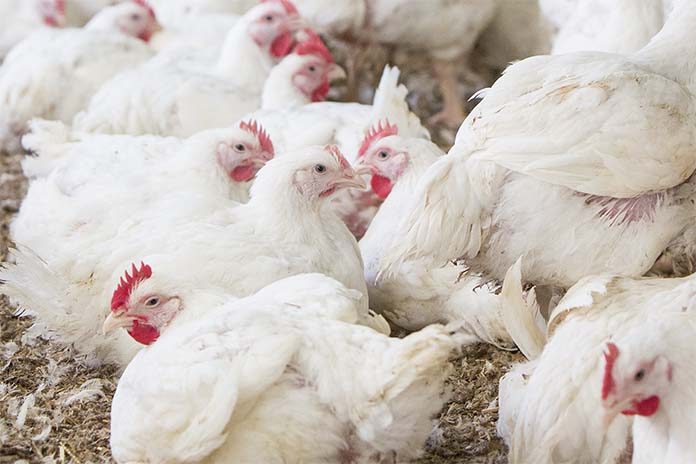
USPOULTRY and the USPOULTRY Foundation announce the completion of a funded research project at the University of Georgia in Athens, Georgia, in which researchers found a practical method to reduce litter moisture.
The research was made possible in part by an endowing Foundation gift from Wayne Farms and is part of the Association’s comprehensive research program encompassing all phases of poultry and egg production and processing. A brief summary of the completed project is shown below. A complete report, along with information on other Association research, may be obtained by going to USPOULTRY’s website, www.uspoultry.org. The project summary is as follows.
In a recently completed research project, Dr. Mike Czarick and colleagues at the University of Georgia studied the use of circulation fans to help reduce litter moisture in broiler houses. They found that increasing air movement at floor level during the life of a flock provided drier litter and improved paw quality. In addition, thermal stratification in a broiler house was reduced and allowed birds to distribute themselves comfortably throughout the house. Using circulation fans to help dry litter appears to cost less than using only conventional ventilation methods.
Evaluation of the Combined Effects of Air Movement and Reduced House Relative Humidity on Bird Health and Welfare in the Early Phase of Commercial Broiler Production
Institution: University of Georgia
Principal Investigator: Michael Czarick, University of Georgia, Poultry Science Department
In today’s broiler industry producers are relying less on antibiotics and putting more attention on animal welfare than ever before. One result of this trend is that growers are being challenged to improve litter management. High litter moisture (>35%) has been correlated with increased risk factors related to bird health and welfare. Litter moisture can be reduced through proper drinker management and ventilation to maintain a low house relative humidity (Rh <50%). Though proper drinker management does not place a financial burden on the grower, the same cannot be said about ventilation rates required to maintain a low Rh. Depending on conditions, decreasing Rh by just 20% could increase heating costs by 45% due to the higher ventilation rates required.
A possible alternative to primarily using ventilation to control litter moisture could be maintaining a moderate Rh level (50-60%) and increasing air movement over the litter through the use of circulation fans. Traditionally, circulation fans have been used primarily to minimize temperature stratification, improve temperature uniformity and conserve energy. Circulation fan systems designed to meet these objectives do not typically produce a significant level of air movement at floor level which limits litter drying. However, to obtain the level of litter drying required to optimize bird health and welfare, a greater level of air movement at floor level is likely needed.
The objective of this study was to evaluate the combined effects of maintaining a moderate house Rh level (50-60%) and moderate level of air movement (150 feet/minute) across the floor on litter moisture, paw health and coccidia sporulation. A total of five flocks were studied on two commercial broiler farms (two houses per farm). One house on each farm did not use circulation fans (control), and an adjacent house (treatment) was equipped with eight 24-inch 1/3 horsepower circulation fans that operated continuously throughout the flock. Both houses on each farm were managed similarly and were ventilated to maintain a moderate Rh of 50-60%.
The study demonstrated that the combination of maintaining a house Rh between 50-60% and an average velocity at floor level of 150 feet/minute resulted in a more consistent environment throughout the house. During cold weather, when temperature uniformity tends to be more problematic, the treatment house temperatures differed by less than 5°F over 99% of the time, while control house temperatures varied less than 5°F only 50% of the time.
Thermal images showed areas beneath tube heaters in control houses often exceeded 120°F during colder weather, while in the treatment houses floor temperatures ranged between 85°F to 100°F. These differences in floor temperatures led to uneven bird distribution in the control house. Birds often gathered near sidewalls to avoid areas under the heaters in control houses, while birds were more evenly distributed in treatment houses. Differences in bird distribution influenced litter moisture profiles. By three weeks, litter moisture was often 20-25% in treatment houses versus 25-35% in control houses. Furthermore, sidewalls in treatment houses tended to be less than 25% in moisture versus >30% in control houses during the cooler times of the year.
With drier litter, footpad lesions were typically lower in treatment houses. By the end of each flock, usually less than 30% of birds scored showed signs of severe lesions in the treatment houses whereas over 50% of birds displayed signs of severe lesions in control houses. If a paw value of $1.00/pound is assumed, the treatment effect could have the potential to save up to $3,000 per year for a 25,000-bird house growing a 4.5-pound bird.
No significant differences in coccidia sporulation were noted between control and treatment houses, which demonstrated that drier litter conditions in the treatment house had no negative impact on oocyst sporulation rates.
The producers observed that ammonia levels were consistently lower in the treatment house. Ammonia measurements taken over the first four weeks of one flock found an approximate 50% reduction in ammonia concentrations in the treatment house versus control (15-25 ppm vs. 30-40 ppm).
Source: www.uspoultry.org.
















